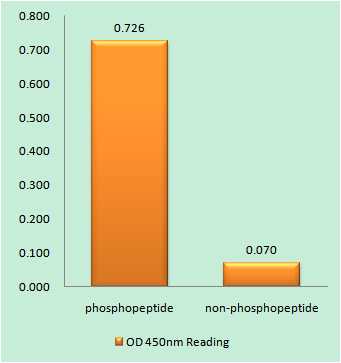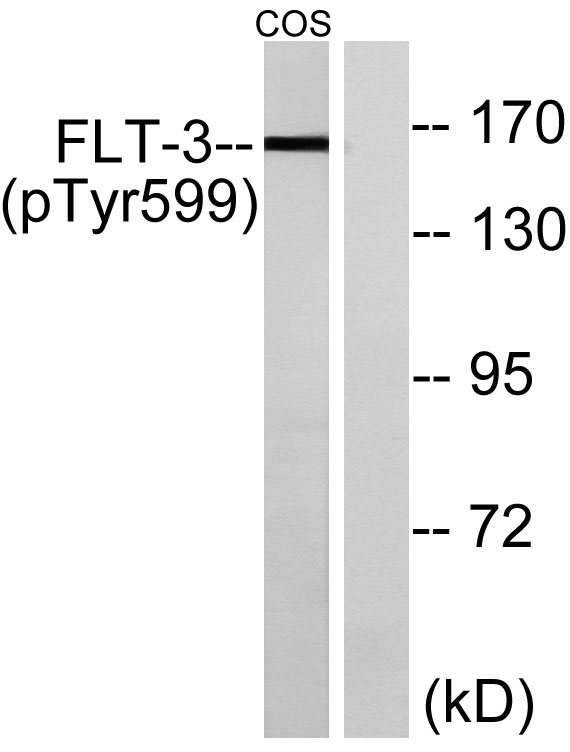Phospho FLT3 (Y969) Cell-Based Colorimetric ELISA Kit
- Catalog No.:KA1702C
- Applications:ELISA
- Reactivity:Human
- Gene Name:
- FLT3
- Human Gene Id:
- 2322
- Human Swiss Prot No:
- P36888
- Mouse Swiss Prot No:
- Q00342
- Storage Stability:
- 2-8°C/6 months
- Other Name:
- Receptor-type tyrosine-protein kinase FLT3 (EC 2.7.10.1) (FL cytokine receptor) (Fetal liver kinase-2) (FLK-2) (Fms-like tyrosine kinase 3) (FLT-3) (Stem cell tyrosine kinase 1) (STK-1) (CD antigen CD135)
- Detection Method:
- Colorimetric
- Background:
- catalytic activity:ATP + a [protein]-L-tyrosine = ADP + a [protein]-L-tyrosine phosphate.,function:Receptor for the FL cytokine. Has a tyrosine-protein kinase activity.,similarity:Belongs to the protein kinase superfamily. Tyr protein kinase family.,similarity:Belongs to the protein kinase superfamily. Tyr protein kinase family. CSF-1/PDGF receptor subfamily.,similarity:Contains 1 Ig-like C2-type (immunoglobulin-like) domain.,similarity:Contains 1 protein kinase domain.,subunit:Interacts with FIZ1 following ligand activation.,tissue specificity:Bone marrow cells.,
- Function:
- cell activation, hemopoietic progenitor cell differentiation, myeloid progenitor cell differentiation, lymphoid progenitor cell differentiation, pro-B cell differentiation, immune system development, leukocyte differentiation, pro-T cell differentiation, negative regulation of immune system process, regulation of leukocyte activation, negative regulation of leukocyte activation, protein amino acid phosphorylation, phosphorus metabolic process, phosphate metabolic process, cell surface receptor linked signal transduction, enzyme linked receptor protein signaling pathway,transmembrane receptor protein tyrosine kinase signaling pathway, positive regulation of cell proliferation, negative regulation of cell proliferation, phosphorylation, hemopoiesis, lymphocyte differentiation, T cell differentiation, T cell activation, regulation of cell proliferation, leukocyte activation, regulation of B
- Subcellular Location:
- Membrane; Single-pass type I membrane protein. Endoplasmic reticulum lumen. Constitutively activated mutant forms with internal tandem duplications are less efficiently transported to the cell surface and a significant proportion is retained in an immature form in the endoplasmic reticulum lumen. The activated kinase is rapidly targeted for degradation.
- Expression:
- Detected in bone marrow, in hematopoietic stem cells, in myeloid progenitor cells and in granulocyte/macrophage progenitor cells (at protein level). Detected in bone marrow, liver, thymus, spleen and lymph node, and at low levels in kidney and pancreas. Highly expressed in T-cell leukemia.
- June 19-2018
- WESTERN IMMUNOBLOTTING PROTOCOL
- June 19-2018
- IMMUNOHISTOCHEMISTRY-PARAFFIN PROTOCOL
- June 19-2018
- IMMUNOFLUORESCENCE PROTOCOL
- September 08-2020
- FLOW-CYTOMEYRT-PROTOCOL
- May 20-2022
- Cell-Based ELISA│解您多样本WB检测之困扰
- July 13-2018
- CELL-BASED-ELISA-PROTOCOL-FOR-ACETYL-PROTEIN
- July 13-2018
- CELL-BASED-ELISA-PROTOCOL-FOR-PHOSPHO-PROTEIN
- July 13-2018
- Antibody-FAQs



